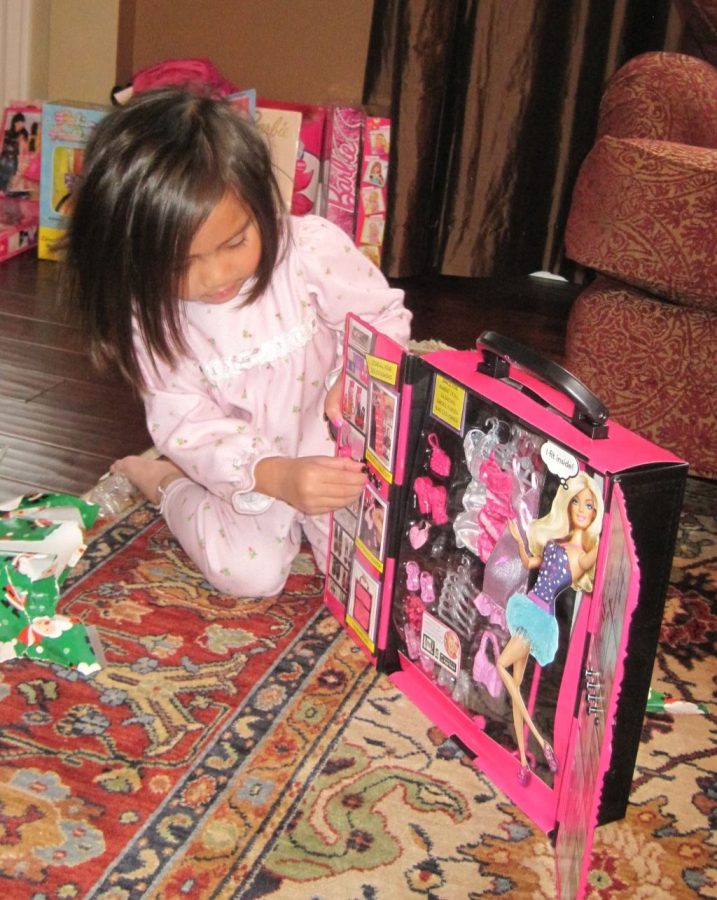Barbie’s impact on BIPOC teens
Sophomore Sydney Isaac, at five years old, unwrapping her “Barbie Fashionista Ultimate Closet Carrying Case.” Isaac enjoyed playing with Barbies as a kid.
February 16, 2023
The first Barbie doll of color, named Christie, was produced in 1968. Since then, Barbie’s creator Mattel Inc. has grown their representation of people of color (POC) and body types. Mattel’s Barbie Diversity page emphasizes the importance of creating a diverse toy box and showcases their 35 Barbie skin tones, 97 hairstyles and nine body types. However, there is always more growth to be done when it comes to the racial representation young girls seek.
Sophomore Sydney Isaac is Filipina and the social media manager for Sisters of Color at Lincoln. She expresses the struggle to find POC representation in her childhood Barbie dolls.
“When I would play with [Barbie] dolls with my friends, we would try to find dolls that resembled us. I could never find one,” said Isaac. “I would always pick the one who had black hair, [and] brown skin, but I didn’t look like those dolls.”
While watching the animated series, “Barbie: Life in the Dreamhouse,” Isaac noticed the smaller roles for POC Barbie dolls.
“There was even an episode where [mainly POC] dolls competed to be [Barbie’s] best friend,” said Isaac. “As people of color, we deserve better than to just be seen as a side character.”
Junior Alex Coltman identifies as mixed race, is president of MEChA and a member of Sisters of Color. She said Barbie dolls affected her childhood.
“When I was younger, I wanted to straighten my hair because the Barbies didn’t have curly hair,” said Coltman. “They [made] the white [doll] the blueprint.”
Along with BIPOC representation, the accessibility of Barbie dolls has been an ongoing issue. There have been multiple cases throughout the years, where big retailers price Black and white Barbie dolls differently. Walmart, Toys-R-Us and Target are a few of the retailers that have charged more for Black Barbies. Each of them released a statement later on, amending what they deemed to be a mistake.
Coltman stresses the importance of accessibility for communities of color when seeking representation in Barbies.
“The American economy is systemically set up so that people of color are put down,” said Coltman. “If we can’t afford a Barbie that looks like us, then [we] are forced to play with the other one and you lose that representation.”
Sophomore Yetta Lorimor is a Black student at Lincoln and a member of Sisters of Color, Black Student Union and Queer BIPOC. Lorimor believes that representing POC is crucial, however, she is concerned that the way representation is accomplished can cause restricting ideas of people.
“You want girls to be able to see themselves in their dolls,” said Lorimor. “The downside comes when they started to label them and make them just a ‘Black Barbie’. It’s putting things in a box.”
Though Barbie dolls used to be named after their races, now, Mattel Inc.’s website does not mention race or skin color in the description of their Barbie dolls. Descriptions of the doll’s hair and body are used instead.
Due to the limited representation available, Coltman believes that certain dolls can feel restrictive when thinking about identity.
“It’s being forced into one box or another box,” said Coltman.
Lorimor hopes that Mattel Inc. will continue to improve Barbie and offer more diversity to young girls around the world.
“You want girls to be able to see themselves in their dolls and like what they see,” said Lorimor.




